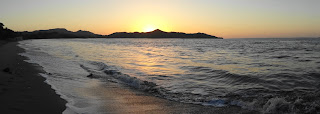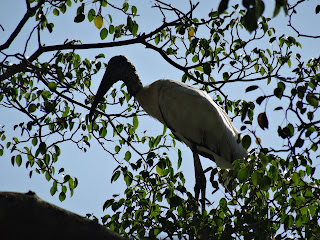On our last full day in Monteverde we did a full day at the Monteverde Cloud Forest Reserve. While it was pretty congested with groups in the first hour or so, once we got deep into the trails and as the day progressed we actually saw very few people, maybe 15 in total between lunch and close at 4:00pm.
There were many new and interesting plants we hadn't seen at Santa Elena or Cerro Tres Amigos. The orchid below sits mid-way up a tree to the side of a suspension bridge which is part of the trail network. A placard notes that a total of 70 species of vascular flora have been documented on that single tree! That doesn't include the mosses, lichens, fungi, insects, birds, etc. that may also call that tree home. For perspective, an entire forest here in Waterloo Region might turn up a couple hundred plant species if it's of average to high quality...I just can't get over the 70 species on a single tree!
A video taken from the suspension bridge (Alyssa didn't know I was filming)
Walking to "La Ventana", a lookout point, we saw this millipede chugging along across the trail at our feet.
A Forest-floor Millipede (Nyssodesmus spp.)
Some plants just had that air of "do not mess with".
Despite the cool temperatures and very high winds, some insects could be found here and there.
But the winds on the east-facing slope were not so hospitable.
Plenty more plants in bloom...
A fruit casing I found off of the side of a trail. I've since come to the conclusion it's likely Rambutan (Nephelium lappaceum), a native to southeast Asia but widely cultivated in Central America. It's like a lychee.
The birding wasn't half bad either! A Black-faced Solitaire was content to feed on fruits right outside of the nature centre. [ebird map]
A couple of Chestnut-capped Brush Finches pecked away at insects off to the side of the trail in an area thick with birds of all sorts.
I was happy to see a Three-striped Warbler for a brief moment. Costa Rica is about as far north as they come.
The Slate-throated Redstarts were socializing in small groups and flew up to us on the trail to pump their tails and flit around.
Alyssa spotted another Black Guan (no head to be seen, again). It silently crept deeper into the canopy before I could get a better view.
And then there was the Resplendent Quetzal, a bird I had hoped to see since the trip was booked, and as luck would have it (our third time over a trail looking for a side trail), there it was. We watched it for about 5 minutes, mostly just perched, tilting it's head around and watching us, but occasionally flying off a branch like a flycatcher to nab an insect. These birds are iconic in Central America (the national bird of Guatemala actually), and we were very fortunate to have seen one. We met people on the trail that I would describe as frantic in their search for one.
It was time to head out and we spotted an Agouti on our way. We had been standing still checking out birds and it walked right at us before high-tailing it into the scrubby understory. They play an important role in seed dispersal, making little caches of various nuts and seeds throughout their range. They weigh up to about 4kg and use scent glands extensively to communicate with other individuals.
When we got back to the nature centre I found out that there was a "Hummingbird Gallery" with about a dozen feeders just packed with every type of hummingbird you could imagine. The Green-crowned Brilliant below was medium-sized in comparison, other species were smaller, others larger, sometimes you'd have 4 species on the same feeder. Females of this species (this one is a female) weigh about 8g.
A Violet Sabrewing shows the variability in the colour of hummingbirds with dark purplish hues which shine a brighter purple when they reflect sunlight. This species was one of the larger ones present and we saw a few throughout the day on the trails (but who could turn down free endless nectar at a feeder?).
A few videos from the feeders. No joke, you can see the bus leaving without me in the background of the last video (with Alyssa urging the Spanish-speaking driver to stop). Wait wait!! hahaha It all came down to my faulty new Timex watch which lost time throughout the day and was a source of stress on several instances throughout the trip. Between BMO putting a block on my credit card and a watch that could be 30-45 minutes off at any time it's a miracle I made it back.
The next day we were catching a bus to our next destination Playa Brasilito (on the Pacific coast, west of Liberia) for 8:00am. I was up early and got in one last bit of balcony birding at our hotel in Monteverde before heading out.
A House Wren kept me company while I scanned some of the nearby trees and the wider valley.
As well as a pair of Blue-Gray Tanagers.
And a nice one to finish things off, a Mountain Thrush was hanging out in the Sloth tree. This species is found in the highland forests and more open edge habitats nearby. It is found from south Mexico through to Panama. [ebird map]
After a 2.5 hour drive down the mountain and out through the dry forests near the coast we got to our hotel at Playa Brasilito, the Hotel Conchal (nice spot, I'd recommend it).
We were greeted by plenty of White-winged Doves coo-ing away from hydro wires, tree tops and eaves troughs.
While kind of common, I was happy to finally get to see a White-throated Magpie-jay.
A Hoffman's Woodpecker sat in a tree while we enjoyed breakfast. Both days I ran back to our room to grab my camera for something perched right beside us. [ebird map]
Another cool breakfast bird, a Streak-backed Oriole [ebird map]. Somewhat similar to the Spot-breasted Oriole.
A few resident Black Ctenosaur sunned themselves on the roof, males pumping their heads up and down aggressively to assert their territory. This one was probably 1.25m long and strutted right beside the pool when I was taking a dip.
We walked the 5 minutes to the beach everyday passing over a brown sand beach then a white shell beach, then onto a white sand beach. Waves were gentle at night but could get to 3-5m during the day which made for the feeling of persistent wave-motion even after leaving the water. We weren't really at a spot where surfers frequent as this beach sit inside a sheltered bay, but there were a few around heading to the local spots.
A nice little back-water lagoon always got a good binocular scan as I passed.
The shallow pooled water harboured a good mix of birds including this Little Blue Heron.
A single Roseate Spoonbill sat perched in a tree over the lagoon one morning.
In the same tree, same morning, a few Wood Storks. Check out the second picture, these guys rival Turkey Vultures for looks.
A nice selection of left-facing birds, White Ibis, Great Egret and Snowy Egret.
When the sun was too hot on my rapidly tanning skin, I'd sit in the shade of the trees and watch the Brown Pelicans fly-by and slam into the water in search of fish.
Sa-MASH!
Nom nom nom...
Royal Terns flew by now and again, at times skimming the water where people swam.
The Great Kiskadee can be differentiated from the Boat-billed Flycatcher by the white supercilliaries (the bands above the eyes) which meet at the back of the head (they don't for the Boat-billed Flycatcher).
There we go, so cooperative.
Briefly a Magnificent Frigatebird flew over, I had never seen one before (not saying alot on this trip) but their form in flight is pretty interesting. The Great Frigatebird, with brown bars on the upperwings has shown up rarely on Cocos Island (a Costa Rican island about 600km southeast of the mainland in the Pacific).
A Spotted Sandpiper skipping over the rocks in non-breeding plumage.
That's Alyssa framed by the tree, on the last day we agreed to do our own thing; she's a fish and loves water, I'm a bush-wacker...who loves scratching through thorny thickets in search of wildlife.
Just before we left for the airport I found this strange plant on a dune near the beach. As the fluffs of white might suggest, it's Upland/Mexican (Gossypium hirsutum). Very cool.
And that's our trip.
A few other interesting sightings we had included:
- Three-wattled Bellbird (never heard anything like it, look it up)
- Neotropic Cormorant (a rare visitor to our neck of the woods but I had never seen one before)
- White-nosed Coati (a mid-sized mammal and relative of the Raccoon)
I had a blast and hope to explore other parts of this beautiful country some day. Now to log some ebird lists!






















































No comments:
Post a Comment